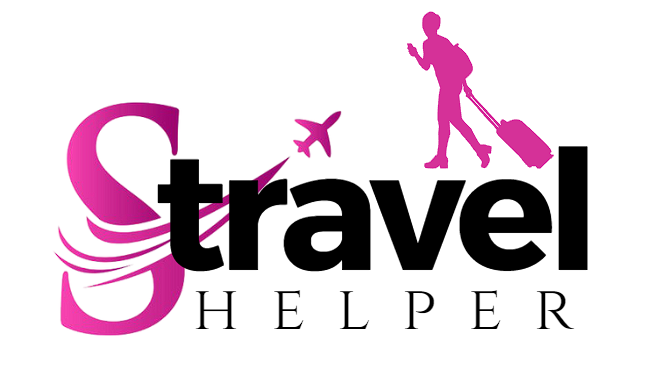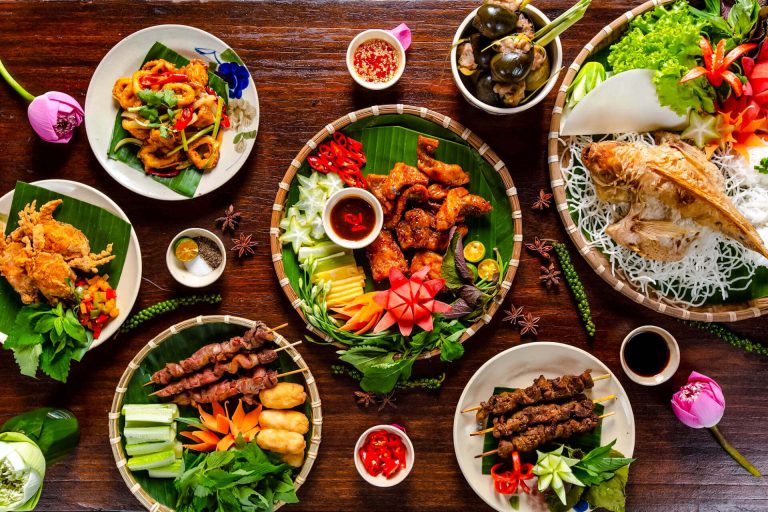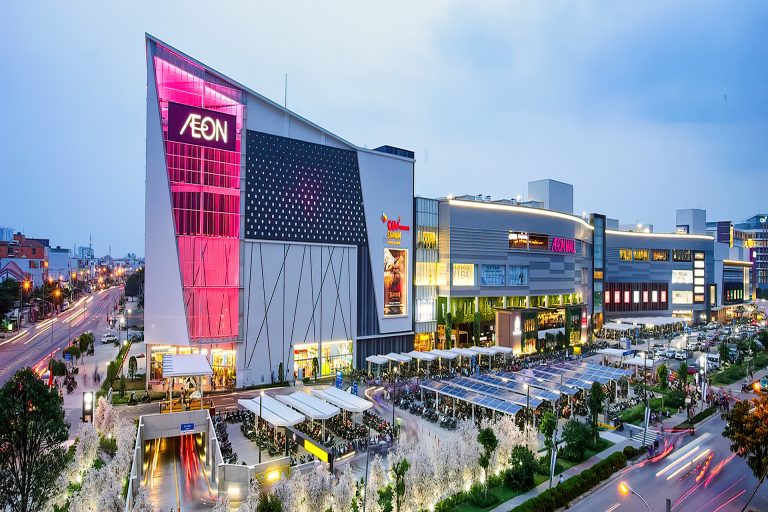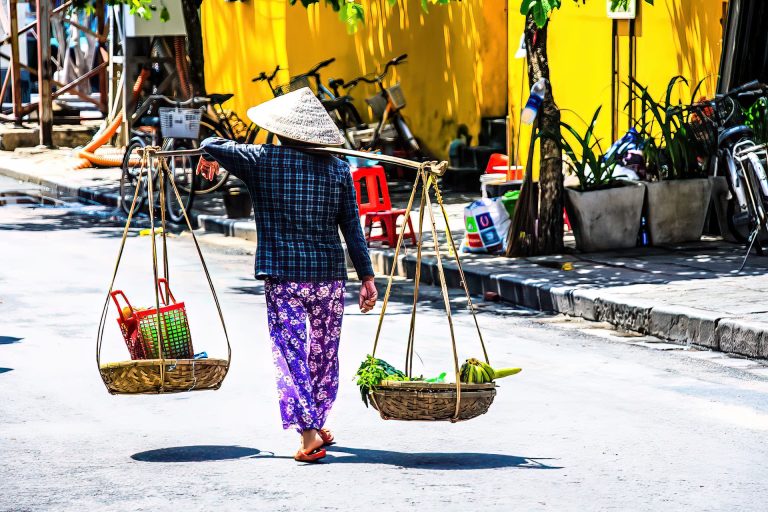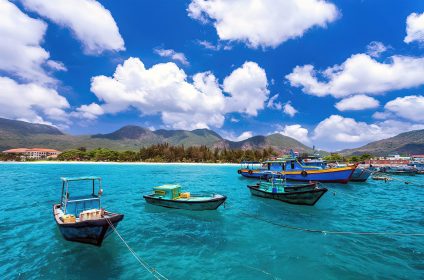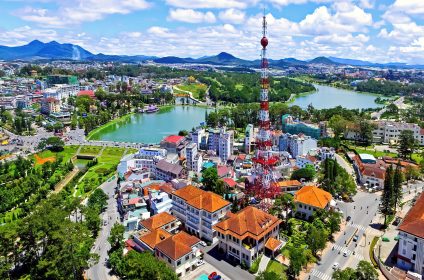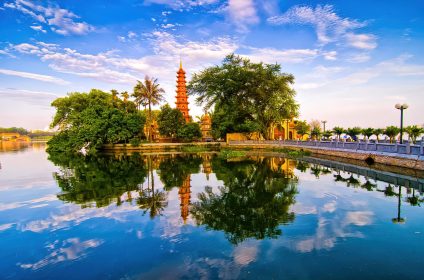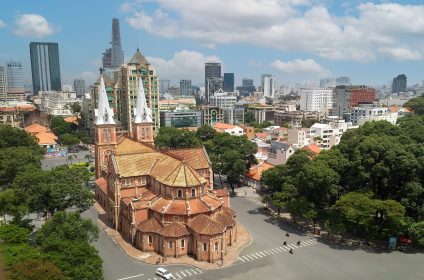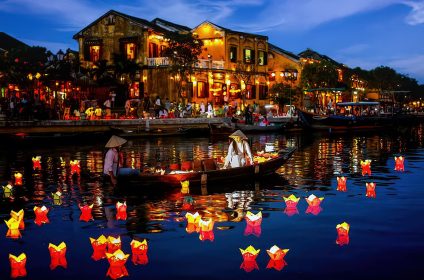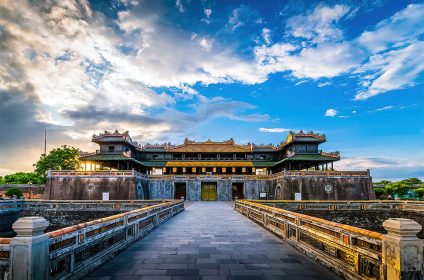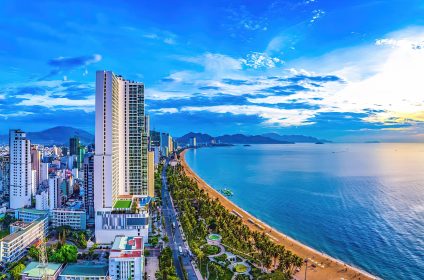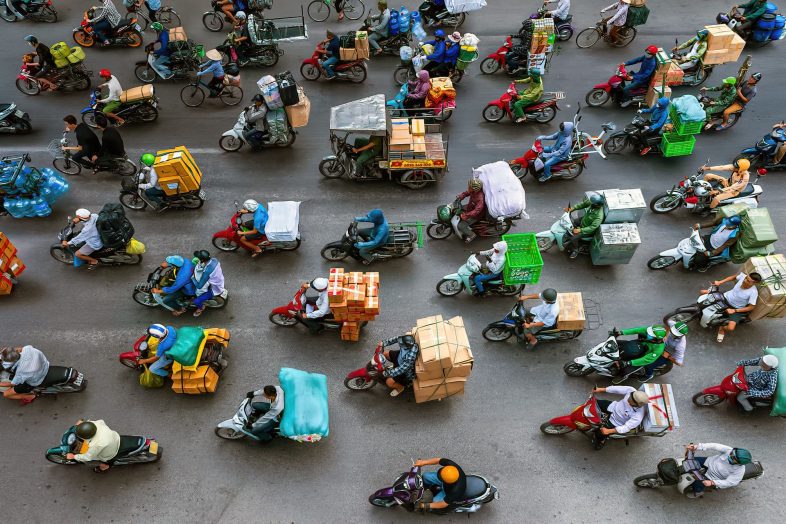
How To Travel Around Vietnam
Vietnam, just like its scenery, has a wide variety of transportation options. You could like motorbike trips filled with wind, point-to-point flights or overland rail and coach journeys following the view.
With some planning (and a taste for adventure) you can usually get to your destination effortlessly and comfortably.
Towns have plenty of taxis, buses, cyclos, while countryside occasionally offers cycling as an attractive option.
Get Around - By Plane
Flights are the fastest way to cross this long country. The flight from Hanoi to HCMC takes only about 2 hours.
Numerous flights connect the two largest cities, Hanoi and HCMC, with major cities such as Da Nang, Hai Phong, Can Tho, Hue, Nha Trang, Da Lat, Phu Quoc. In the past, most of these flights were cheap compared to European or North American flights. However, prices are higher than before, e.g. a round trip between Hanoi and Da Nang costs about 120-150 USD including taxes.
The national carriers are Vietnam Airlines and its subsidiary Vasco, which operate shorter flights, Jetstar Pacific and VietJet.
Get Around - By Train
The train, although more costly than the bus, is perhaps the most convenient way to go by land in Vietnam. There is only one major rail route in Vietnam – the main line that extends 1,723 km from Hanoi to Ho Chi Minh City and on which Reunification Express operates. The journey from HCMC to Hanoi takes over 30 hours, and it makes sense to stay overnight between major points if not required by timetable. It’s still as uncomfortable as a bus but offers great opportunity to see rural areas inhabited by rich city dwellers.
It would be good to reserve an air-conditioned soft or hard berth since the most popular berths and routes tend to be purchased by travel agencies well before departure time (so if at a station counter or at the office of a renowned tourist company you are told that the train is full, this does not mean there are no more tickets – they have just been sold through another agency). Booking at a station is better for your safety. Just write where you want to go, when and how many people along with their class on any piece of paper. Last minute buyers loitering around stations can nevertheless buy unsold tickets – almost every train could fit few more cars provided high demand suggests thus such situations happen rather frequently. As these tickets get closer prices come down about them Tickets can also be refunded prior to departure with 10% charge Tickets may likewise be purchased via an official Vietnamese Railways website with English version accepting international credit cards.
One thing that should be remembered when purchasing railway tickets via tour operators is that there will be no indication what class the booking has been made on behalf of you. This eventually results in a common scam among private travel firms where they take payment from you for booking soft sleeper ticket after which buy much cheaper hard sleeper ticket instead; however, once aboard one realizes that he/she has been tricked into lower class sleeping place. But once the train starts moving, it is impossible to return to the conman and ask for money back.
However, there are also shorter routes from Hanoi towards northwest and northeast with international links into China. There are a few of Vietnam’s fastest and most popular trains including sleeper connection from Hanoi to Lao Cai (and then by bus to Sapa).
It is always better to get tickets at least 3 days in advance if not earlier especially during peak holiday season when booking should be done at least two weeks earlier.
Buying train tickets in Vietnam
You can buy your train tickets at counters in Vietnam’s train stations days or months in advance of your trip, depending on the route. Train tickets are also sold through many travel agencies and online through Vietnam’s official train ticketing website.
Children above 5 years old are charged the full ticket price.
All trains have western and squat toilets on both ends of every carriage.
Luggage transport and freight forward service is available on Reunification Express Trains
The Reunification Express
It’s not a train, the Reunification Express, but rather a rail line linking Hanoi and Ho Chi Minh City that was built by the French in 1936. The scenic trip takes 36 hours with stops at Hue, Danang, Nha Trang and Phan Thiet. Five trains operate on this route daily (7:30PM; 10PM; 6AM; 9AM; 1:10PM) from each of these cities. Point to note is that there are four kinds of seats available: hard seat or bare wooden chair, comfortable soft seat with back rest, hard sleeper or padded bench which can be turned to beds and soft sleeper which is the most luxurious one. They have a basic bed layout with four cabins per car.
Get Around - By Bus
Most cities in Vietnam are served by long-distance buses. Most depart early in the morning to avoid traffic in the late afternoon and rain, or travel overnight. One thing to note is that even short distances between cities usually take a lot of time due to slow speeds along the roads. By way of illustration, this distance if traveled by bus can take about 8 hours only.
There are public buses that ply between bus stations within cities. In bigger cities like Ho Chi Minh City, there may be necessary for one to use local transport to reach the city centre. The buses are typically in good shape and you have chances to talk with people from different walks of life.
Open tour buses come under many different firms comprising various travel tours. They cater mainly for tourists and offer very low rates (e.g., Hanoi-HCMC: 20-25 USD) as well as door-to-door services going directly to the hostel where you want to sleep on a given night. One can break up the trip at any point and carry on using another bus from the same company or otherwise buy tickets specifically for that planned stopover. There is however no need for more than three or four stopovers because buying separate tickets may be more cost effective example being Hanoi-Hue trip which sometimes costs only 5 USD ). It is possible for most hotels/guesthouses to make reservations for every connection but it’s better checking with your travel agent since prices differ depending on bus company as well as per ticket. You should ask at least half an hour before departure time at a bus company office if they can give you commission-free fare; nonetheless, it is important noting that major bus companies often don’t accept any deviation from their flat rate except through agents.
Tour companies charge so little on these tours because they get commissions for stops made which are just souvenir shops where nothing needs buying. Estimated time for buses is not accurate and due to number of stops it can sometimes take a few hours extra. Moreover, picking up passengers at the beginning of the journey may also take a long time. Therefore, one has to be at least half an hour early before the bus arrives. At night stopovers and particularly in night buses there are many bushes.
Vietnamese buses are designed for Vietnamese – tall Westerners will feel very uncomfortable, especially on the night buses. Also, many Vietnamese are not used to travelling on long-distance buses and sometimes get sick – which is not very pleasant when you are stuck on a night bus with several vomiting Vietnamese behind you.
In any case, if one feels somewhat sick on board it is better to reserve middle seat instead of front ones. Firstly, you do not see blind risks that drivers sometimes take on roads. Secondly, this way you manage somehow to stay away from incessant honking (each time the bus overtakes another vehicle which happens about every 10 seconds).
It is however always possible to arrange a pick-up at your hotel or guest house, but it is easier to go to the office of the bus company so that you have choice of seats and avoid being seated in the back or far from your fellow passengers. You can find their offices located within or near the tourist regions of this city, hence moving around makes your trip more exciting.
There are only long-distance bus companies having services along this single main road (QL1) running north-south. The bus will drop you off where it finds it most convenient and not at a bus station as you might imagine if you take a bus too far for your destination. This junction is 13 km from Hue’s city centre and Nha Trang lies approximately 10 km away. Taxis and motorbike taxis are available here that will take you to your hotel.
If going by bike, agree on the additional payment with driver before buying a ticket rather than at the counter where tickets are sold. The price for bicycle should not exceed 10% of its cost.
The first one is when tour guides inquire whether someone has booked a hotel on arrival. But even if you haven’t, tell them about some hotel that exists there; “I already have one.” In case they realize that you do not have any accommodation yet, they will hire a taxi for you and probably take you to some place where they can get commission out of every deal made there. If however they insist, things can become sticky when they demand payment for taxi fare which could be quoted as several times what was initially agreed upon assuming it was ten-minute drive price.
Remember that on night buses there have been times when people including drivers were rummaging through bags belonging to passengers stealing such valuables like iPhones or iPods which were later sold off cheaply. Your iPod may disappear overnight if you fall asleep with it still in your ear while traveling with it. Just use a padlock to secure your hand luggage and lock everything in it before you go to sleep.
Get Around - By Car
International driver’s licenses are accepted in Vietnam. However, the concept of renting a car to drive yourself is nearly non-existent, and when Vietnamese talk about renting a car, they always imply renting a car with a driver (after a short time on the local roads with their crazy traffic, you will be glad to have someone else drive you). Due to the fact that few Vietnamese own cars, they frequently have the choice of hiring vehicles for family vacations, special celebrations, and so on. For a day or longer, the Vietnamese can easily charter anything from a tiny automobile to a 32-seater bus.
Tourists can indirectly access this sector through hotels and travel companies in all tourist locations. Furthermore, international automotive brands have begun to appear. Budget Automobile Rental, one of the world’s leading car rental firms, now provides chauffeur-driven rental cars in Vietnam. A compact car rental for a day returning to the starting location costs around $60 USD for 8 hours (although the price varies depending on fuel costs). (If you shop about and haggle hard for the best deal, you’re likely to acquire an older, beat-up car. If you’re spending more than you need to, consider what kind of car you’ll be getting and whether it’ll be comfy. Because few drivers know English, you should inform the hotel/agent of your destination and express it to the driver.
Overland travel can also be accomplished by hiring a car and driver, though at a slightly higher expense. A modest car from Saigon to Mui Ne, a four- or five-hour drive depending on traffic, costs around 70 USD, and a car from Dalat to Mui Ne costs around 90 USD. Long-distance travel by car can be a wonderful option for groups of individuals traveling together because it allows for a flexible schedule and access to remote destinations. Remember that long-distance travel in Vietnam is slow, with an average speed of less than 50km/h regardless of method of transport (bus or car). Highway 1, which runs north-south through the country, is a two-lane route with substantial truck and bus traffic.
To call Vietnamese driving practices in general awful would be an understatement. On the road, courtesy is non-existent, and drivers rarely check their blind spots or mirrors (many vehicles have even had their side mirrors removed). Vietnamese drivers often frequently hoot to keep motorcyclists and cyclists at bay. Furthermore, most roads are not marked, and even on those that are, drivers are sometimes unaware of the lane markers. As a result, driving yourself in Vietnam is not recommended, and you should leave your transportation needs to locals.
Get Around - By Bike
Adventurers may like to explore Vietnam by bike. Many adventure excursions provide package tours that include equipment. Because the majority of the populace travels on two wheels, it’s a terrific way to get closer to the people while straying off the usual path.
Bicycles are inexpensive to rent in many locations and are an excellent way to travel big distances. Cycling is popular in Dalat, Hoi An, Hue, and Ninh Binh. Trying to cycle in Hanoi or Ho Chi Minh City (HCMC) without any experience with traffic laws (or lack thereof, ‘adequate experience’ in this situation means recognizing that anyone around you could theoretically change direction without signs and at any time) is nearly suicide.
Bicycle parking is not permitted in pedestrian zones in cities such as HCMC and Hanoi, and it costs 2000 dong each bicycle.
Get Around - With The Motorbike Taxi
A motorbike taxi, or xe ôm (literally “cuddly vehicle”), is a popular means of transportation for both Vietnamese and visitors. They are extensively available and reasonably priced, costing around 10,000 dong for a 10-minute ride that will take you anywhere in the city center. As you go through the city streets, every two minutes, a man will indicate you and say, “You! Motorbike?” Longer journeys to outlying places can be arranged for 20,000-25,000 dong. Always settle on a price before embarking on your journey.
Motorcyclists almost never speak English. As with other things, a tourist is frequently charged a price that is higher than the market in the outset, and you must be tough. If the quoted fee for a short ride is more than 10,000 dongs, remind the driver that you can take an air-conditioned cab for 15,000 dongs, so forget it. Drivers may charge more than the final discussed fee, therefore it is best to have exact change on hand. You can then leave after paying the agreed-upon amount.
In some circumstances, they will transport you wherever they want (tourist spots or businesses you did not request), and in others, they will wait for you to return (even if you do not want them to) and charge you more money for the delay. Even if you speak some Vietnamese, it won’t help because they’ll still lie to you or pretend they don’t understand even if they do. Be firm once more and walk away.
Get Around - With The Motorbike
The number one preferred mode of transportation among Vietnamese is the 110cc motorbike, with a huge number of them being found in the capital and other major cities. In typical cases, whole families of four ride on one motorbike. It costs between VND100,000-160,000 per day to rent a car in most tourist areas.
However remember that you are not allowed to drive motorcycles unless you have a temporary Vietnamese motorbike license or international ones with motorcycle licenses that are valid in your own countries.
For you to be given a three month temporary Vietnamese driving license from your driving license or international driving license you must posses either three months touristic visa or three month Vietnamese residency permit. Hanoi Training & Automotive Mechanics Center at 83A Ly Thuong Kiet Street (63 Ly Tu Trong Street District 1, Ho Chi Minh City under Traffic Bureau)
The two main types of bikes for hire are the automatic scooter and a four-speed motorbike with left-side gear shift. The Honda Super Cub is a popular semi-automatic four-stroke moped with no clutch, so it is easy to ride. Others may be all manual, meaning that you have to use your left hand to operate the clutch – this is very difficult, plus it’s possible to over-rev and do a wheelie or stall the engine – if you find yourself with that kind of a bike, practice letting go of the clutch slowly before hitting the road! Dirt bikes are becoming increasingly popular in Hanoi; however, they are not yet available out of this town. Rental salespeople tend to give foreigners scooters as opposed to motorcycles because they understand that foreigners cannot drive motorcycles with gears on them anyway. Motorbikes above 175 cc engine capacity are legal only if you join a Vietnamese motorcycle club.
Most places where you need to stop will have numbered boards installed there for safe parking of your bike. In some cases, these facilities control such activities while others establish separate businesses around busy areas. Rows of bicycles can often be seen parked together somewhere in town. You could either park it by yourself depending on situations or just remove its key and place it in neutral so that staff could put it wherever they want. Key should never leave your hands except under rare circumstances when you park at restaurants and cafes (search “giu xe mien phi”). For other places prices range from 2,000 dongs to 5,000 then 10,000 dongs.
A lot of people get stopped by traffic police in cities for reasons which may not include any misconduct whatsoever but they rarely target non-Vietnamese speakers for fear that communication breakdowns could only worsen their situation. Nonetheless, we must obey traffic rules especially if one does not have Vietnamese driving license. Many one-way streets still exist in cities such as Hanoi and Ho Chi Minh City that can be mistakenly driven into because of poor road signage. And if you breach the rule then some cops just standing at the right spot will ask you to park your bike then fine you. They will also tell you that they are going to take your bike away. You can negotiate the fine, and if you are apologetic and polite, you could be back on the road in no time for a couple of dollars out of pocket. Furthermore, nobody would really trouble or menace you.
Since December 2007 helmets have been obligatory; therefore, if you don’t have one already get it from your landlord. Otherwise, riding without a helmet is an invitation for policemen to stop cyclists.
Get Around - With Cyclo
Despite being gradually superseded by motorbikes, cyclo-pedicabs continue to prowl the streets of Vietnam’s towns and villages. They are especially frequent in picturesque and less crowded little towns like Hue, where walking slowly while viewing the surroundings is enjoyable. Although the trip is slow, hot, and occasionally dangerous, it is frequently more expensive than a motorbike for the same distance.
On the other side, some drivers (particularly in the south) are extremely courteous and eager to provide commentary on the views. Cyclo drivers are famously greedy for money and will always demand a high starting charge. (Japanese visitors, especially women, are most commonly the target of this scam as they are more sensitive to the threat that the driver would call the police and cause them difficulty if they do not pay as required). A acceptable fee for a maximum distance of 2km is roughly 20,000 dongs, and if the driver does not agree, simply walk away (you won’t get far before this or another driver accepts your offer). Prices for a sightseeing tour with stops are more difficult to negotiate and, as a result, more likely to result in disagreement.
If you intend to stop anywhere for a time, make arrangements with the driver, make no promises, and begin again later. Some drivers begin with a very low fee to entice you into their system, and when you expect or need to change the agreed-upon price, they take out a typed pricing list with their “normal fares,” which are exorbitantly inflated. If in doubt, request that the driver show you his price list. Then either negotiate from there or walk away. To avoid problems, make sure you have exact change for the agreed-upon amount with you. If the driver tries to amend the terms of the contract, you can just put your money on the seat and walk away.
Get Around - With Boat
If you do not spend some time on a boat, you will lose out on a big part of Vietnamese life. However, be cautious because many boats are seaworthy but not built to first-world standards. One example is the ferry from Phu Quoc to the mainland. All passengers embark this vessel through a modest entrance. When it is fully occupied, which is most of the time, there are approximately 200 people on board. In the event of a disaster, the chances of everyone getting off the boat in time are quite remote. In this instance, there is no such thing as an emergency exit.
Tour boats can be leased for about $20 USD for a day visit; nevertheless, when chartering a boat, be cautious about safety. Check that the boat is licensed for tourist traffic and that there are enough life jackets and other safety equipment on board. You can also book a tour through a travel agency, but keep in mind that most travel companies in Vietnam charge whatever margin they like, so the tourist frequently pays a margin of 30-40% and the owner and operator of the boat (from van to boat, etc.) receives relatively little of the entire money.
Ha Long Bay is well-known for one- to three-day boat tours between its gorgeous limestone islands. The issue is that all of the boats appear to sail to the same destinations – and with the high pricing, low quality of boats and service, it’s difficult to discover true value. Many boats charge a $10 corkage fee and do not allow BYO alcohol, but wine and seafood on board are roughly the same price as in Europe. You may not be able to see much if there is rain, fog, or low-hanging clouds. Choose a clear day if possible.
In Hue, dozens of small family boats navigate the river, transporting visitors to the imperial tombs southwest of the city. The boats are slow and take around 4 hours to sail one way, so this is a long trek.
Nha Trang, Hoi An, and Phu Quoc all provide snorkeling and fishing expeditions to adjacent islands. The northeast monsoon season inhibits boat trips in central Vietnam from September to February; other areas of Vietnam appear to be less affected.
A 90-minute hydrofoil ride from Saigon to the seaside resort of Vung Tau costs around 200,000 dongs each way and is the quickest way to go to the beach from the city.
The river cruises are possibly the most exciting. Almost every tour in the Mekong region includes a day journey by boat.

